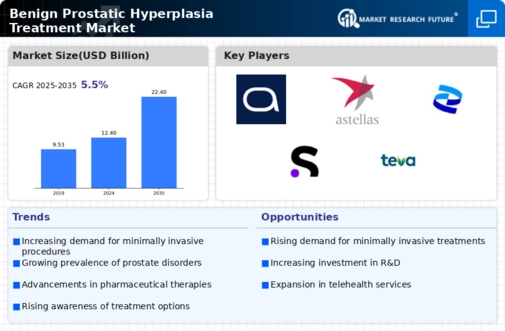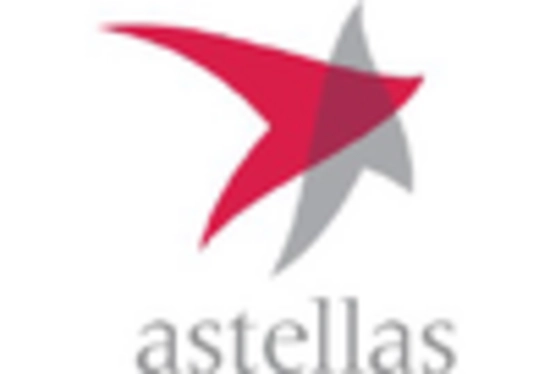-
EXECUTIVE SUMMARY
-
MARKET INTRODUCTION
-
Definition
-
Scope of the Study
- Research Objective
- Assumptions
- Limitations
-
RESEARCH METHODOLOGY
-
\r\n
-
Overview
-
\r\n
-
Data Mining
-
Secondary Research
-
Primary Research
- Primary Interviews and Information Gathering Process
- Breakdown of Primary Respondents
-
Forecasting Modality
-
Market Size Estimation
- Bottom-Up Approach
- Top-Down Approach
-
Data Triangulation
-
Validation
-
MARKET DYNAMICS
-
Overview
-
Drivers
-
Restraints
-
Opportunities
-
MARKET FACTOR ANALYSIS
-
Value Chain Analysis
-
Porter’s Five Forces Analysis
- Bargaining Power of Suppliers
- Bargaining Power of Buyers
- Threat of New Entrants
- Threat of Substitutes
- Intensity of Rivalry
-
COVID-19 Impact Analysis
- Market Impact Analysis
- Regional Impact
- Opportunity and Threat Analysis
-
GLOBAL BENIGN PROSTATIC HYPERPLASIA TREATMENT MARKET, BY THERAPEUTICS CLASS
-
Overview
-
Alpha blockers
-
5- alpha reductase inhibitors
-
Phosphodiesterase-5 inhibitors
-
Others
-
GLOBAL BENIGN PROSTATIC HYPERPLASIA TREATMENT MARKET, BY THERAPY
-
Overview
-
Mono drug therapy
-
Combination drug therapy
-
GLOBAL BENIGN PROSTATIC HYPERPLASIA TREATMENT MARKET, BY REGION
-
Overview
-
North America
- U.S.
- Canada
-
Europe
- Germany
- France
- U.K
- Italy
- Spain
- Rest of Europe
-
Asia-Pacific
- China
- India
- Japan
- South Korea
- Australia
- Rest of Asia-Pacific
-
Rest of the World
- Middle East
- Africa
- Latin America
-
COMPETITIVE LANDSCAPE
-
Overview
-
Competitive Analysis
-
Market Share Analysis
-
Major Growth Strategy in the Global Benign Prostatic Hyperplasia Treatment Market,
-
Competitive Benchmarking
-
Leading Players in Terms of Number of Developments in the Global Benign Prostatic Hyperplasia Treatment Market,
-
Key developments and Growth Strategies
- New THERAPEUTICS CLASS Launch/Therapy Deployment
- Merger & Acquisitions
- Joint Ventures
-
Major Players Financial Matrix
- Sales & Operating Income, 2022
- Major Players R&D Expenditure. 2022
-
COMPANY PROFILES
-
Abbott Laboratories
- Company Overview
- Financial Overview
- Therapeutics Class Offered
- Key Developments
- SWOT Analysis
- Key Strategies
-
AbbVie (Allergan Plc)
- Company Overview
- Financial Overview
- Therapeutics Class Offered
- Key Developments
- SWOT Analysis
- Key Strategies
-
Astellas Pharma Inc.
- Company Overview
- Financial Overview
- Therapeutics Class Offered
- Key Developments
- SWOT Analysis
- Key Strategies
-
Boehringer Ingelheim Pharma GmbH & Co. KG
- Company Overview
- Financial Overview
- Therapeutics Class Offered
- Key Developments
- SWOT Analysis
- Key Strategies
-
Eli Lilly and Company
- Company Overview
- Financial Overview
- Therapeutics Class Offered
- Key Developments
- SWOT Analysis
- Key Strategies
-
GlaxoSmithKline plc.
- Company Overview
- Financial Overview
- Therapeutics Class Offered
- Key Developments
- SWOT Analysis
- Key Strategies
-
Merck & Co., Inc. (Merck Sharp & Dohme Corp)
- Company Overview
- Financial Overview
- Therapeutics Class Offered
- Key Developments
- SWOT Analysis
- Key Strategies
-
Pfizer Inc.
- Company Overview
- Financial Overview
- Therapeutics Class Offered
- Key Developments
- SWOT Analysis
- Key Strategies
-
Sanofi
- Company Overview
- Financial Overview
- Therapeutics Class Offered
- Key Developments
- SWOT Analysis
- Key Strategies
-
Teva Pharmaceutical Industries Limited
- Company Overview
- Financial Overview
- Therapeutics Class Offered
- Key Developments
- SWOT Analysis
- Key Strategies
-
APPENDIX
-
References
-
Related Reports
-
-
LIST OF TABLES
-
GLOBAL BENIGN PROSTATIC HYPERPLASIA TREATMENT MARKET, SYNOPSIS, 2018-2032
-
GLOBAL BENIGN PROSTATIC HYPERPLASIA TREATMENT MARKET, ESTIMATES & FORECAST, 2018-2032 (USD BILLION)
-
GLOBAL BENIGN PROSTATIC HYPERPLASIA TREATMENT MARKET, BY THERAPEUTICS CLASS, 2018-2032 (USD BILLION)
-
GLOBAL BENIGN PROSTATIC HYPERPLASIA TREATMENT MARKET, BY THERAPY, 2018-2032 (USD BILLION)
-
NORTH AMERICA BENIGN PROSTATIC HYPERPLASIA TREATMENT MARKET, BY THERAPEUTICS CLASS, 2018-2032 (USD BILLION)
-
NORTH AMERICA BENIGN PROSTATIC HYPERPLASIA TREATMENT MARKET, BY THERAPY, 2018-2032 (USD BILLION)
-
NORTH AMERICA BENIGN PROSTATIC HYPERPLASIA TREATMENT MARKET, BY COUNTRY, 2018-2032 (USD BILLION)
-
U.S. BENIGN PROSTATIC HYPERPLASIA TREATMENT MARKET, BY THERAPEUTICS CLASS, 2018-2032 (USD BILLION)
-
U.S. BENIGN PROSTATIC HYPERPLASIA TREATMENT MARKET, BY THERAPY, 2018-2032 (USD BILLION)
-
CANADA BENIGN PROSTATIC HYPERPLASIA TREATMENT MARKET, BY THERAPEUTICS CLASS, 2018-2032 (USD BILLION)
-
CANADA BENIGN PROSTATIC HYPERPLASIA TREATMENT MARKET, BY THERAPY, 2018-2032 (USD BILLION)
-
EUROPE BENIGN PROSTATIC HYPERPLASIA TREATMENT MARKET, BY THERAPEUTICS CLASS, 2018-2032 (USD BILLION)
-
EUROPE BENIGN PROSTATIC HYPERPLASIA TREATMENT MARKET, BY THERAPY, 2018-2032 (USD BILLION)
-
EUROPE BENIGN PROSTATIC HYPERPLASIA TREATMENT MARKET, BY COUNTRY, 2018-2032 (USD BILLION)
-
GERMANY BENIGN PROSTATIC HYPERPLASIA TREATMENT MARKET, BY THERAPEUTICS CLASS, 2018-2032 (USD BILLION)
-
GERMANY BENIGN PROSTATIC HYPERPLASIA TREATMENT MARKET, BY THERAPY, 2018-2032 (USD BILLION)
-
FRANCE BENIGN PROSTATIC HYPERPLASIA TREATMENT MARKET, BY THERAPEUTICS CLASS, 2018-2032 (USD BILLION)
-
FRANCE BENIGN PROSTATIC HYPERPLASIA TREATMENT MARKET, BY THERAPY, 2018-2032 (USD BILLION)
-
ITALY BENIGN PROSTATIC HYPERPLASIA TREATMENT MARKET, BY THERAPEUTICS CLASS, 2018-2032 (USD BILLION)
-
ITALY BENIGN PROSTATIC HYPERPLASIA TREATMENT MARKET, BY THERAPY, 2018-2032 (USD BILLION)
-
SPAIN BENIGN PROSTATIC HYPERPLASIA TREATMENT MARKET, BY THERAPEUTICS CLASS, 2018-2032 (USD BILLION)
-
SPAIN BENIGN PROSTATIC HYPERPLASIA TREATMENT MARKET, BY THERAPY, 2018-2032 (USD BILLION)
-
U.K BENIGN PROSTATIC HYPERPLASIA TREATMENT MARKET, BY THERAPEUTICS CLASS, 2018-2032 (USD BILLION)
-
U.K BENIGN PROSTATIC HYPERPLASIA TREATMENT MARKET, BY THERAPY, 2018-2032 (USD BILLION)
-
REST OF EUROPE BENIGN PROSTATIC HYPERPLASIA TREATMENT MARKET, BY THERAPEUTICS CLASS, 2018-2032 (USD BILLION)
-
REST OF EUROPE BENIGN PROSTATIC HYPERPLASIA TREATMENT MARKET, BY THERAPY, 2018-2032 (USD BILLION)
-
ASIA PACIFIC BENIGN PROSTATIC HYPERPLASIA TREATMENT MARKET, BY THERAPEUTICS CLASS, 2018-2032 (USD BILLION)
-
ASIA PACIFIC BENIGN PROSTATIC HYPERPLASIA TREATMENT MARKET, BY THERAPY, 2018-2032 (USD BILLION)
-
ASIA PACIFIC BENIGN PROSTATIC HYPERPLASIA TREATMENT MARKET, BY COUNTRY, 2018-2032 (USD BILLION)
-
JAPAN BENIGN PROSTATIC HYPERPLASIA TREATMENT MARKET, BY THERAPEUTICS CLASS, 2018-2032 (USD BILLION)
-
JAPAN BENIGN PROSTATIC HYPERPLASIA TREATMENT MARKET, BY THERAPY, 2018-2032 (USD BILLION)
-
CHINA BENIGN PROSTATIC HYPERPLASIA TREATMENT MARKET, BY THERAPEUTICS CLASS, 2018-2032 (USD BILLION)
-
CHINA BENIGN PROSTATIC HYPERPLASIA TREATMENT MARKET, BY THERAPY, 2018-2032 (USD BILLION)
-
INDIA BENIGN PROSTATIC HYPERPLASIA TREATMENT MARKET, BY THERAPEUTICS CLASS, 2018-2032 (USD BILLION)
-
INDIA BENIGN PROSTATIC HYPERPLASIA TREATMENT MARKET, BY THERAPY, 2018-2032 (USD BILLION)
-
AUSTRALIA BENIGN PROSTATIC HYPERPLASIA TREATMENT MARKET, BY THERAPEUTICS CLASS, 2018-2032 (USD BILLION)
-
AUSTRALIA BENIGN PROSTATIC HYPERPLASIA TREATMENT MARKET, BY THERAPY, 2018-2032 (USD BILLION)
-
SOUTH KOREA BENIGN PROSTATIC HYPERPLASIA TREATMENT MARKET, BY THERAPEUTICS CLASS, 2018-2032 (USD BILLION)
-
SOUTH KOREA BENIGN PROSTATIC HYPERPLASIA TREATMENT MARKET, BY THERAPY, 2018-2032 (USD BILLION)
-
REST OF ASIA-PACIFIC BENIGN PROSTATIC HYPERPLASIA TREATMENT MARKET, BY THERAPEUTICS CLASS, 2018-2032 (USD BILLION)
-
REST OF ASIA-PACIFIC BENIGN PROSTATIC HYPERPLASIA TREATMENT MARKET, BY THERAPY, 2018-2032 (USD BILLION)
-
REST OF WORLD BENIGN PROSTATIC HYPERPLASIA TREATMENT MARKET, BY THERAPEUTICS CLASS, 2018-2032 (USD BILLION)
-
REST OF WORLD BENIGN PROSTATIC HYPERPLASIA TREATMENT MARKET, BY THERAPY, 2018-2032 (USD BILLION)
-
REST OF WORLD BENIGN PROSTATIC HYPERPLASIA TREATMENT MARKET, BY COUNTRY, 2018-2032 (USD BILLION)
-
MIDDLE EAST BENIGN PROSTATIC HYPERPLASIA TREATMENT MARKET, BY THERAPEUTICS CLASS, 2018-2032 (USD BILLION)
-
MIDDLE EAST BENIGN PROSTATIC HYPERPLASIA TREATMENT MARKET, BY THERAPY, 2018-2032 (USD BILLION)
-
AFRICA BENIGN PROSTATIC HYPERPLASIA TREATMENT MARKET, BY THERAPEUTICS CLASS, 2018-2032 (USD BILLION)
-
AFRICA BENIGN PROSTATIC HYPERPLASIA TREATMENT MARKET, BY THERAPY, 2018-2032 (USD BILLION)
-
LATIN AMERICA BENIGN PROSTATIC HYPERPLASIA TREATMENT MARKET, BY THERAPEUTICS CLASS, 2018-2032 (USD BILLION)
-
LATIN AMERICA BENIGN PROSTATIC HYPERPLASIA TREATMENT MARKET, BY THERAPY, 2018-2032 (USD BILLION)
-
-
LIST OF FIGURES
-
RESEARCH PROCESS
-
MARKET STRUCTURE FOR THE GLOBAL BENIGN PROSTATIC HYPERPLASIA TREATMENT MARKET
-
MARKET DYNAMICS FOR THE GLOBAL BENIGN PROSTATIC HYPERPLASIA TREATMENT MARKET
-
GLOBAL BENIGN PROSTATIC HYPERPLASIA TREATMENT MARKET, SHARE (%), BY THERAPEUTICS CLASS, 2022
-
GLOBAL BENIGN PROSTATIC HYPERPLASIA TREATMENT MARKET, SHARE (%), BY THERAPY, 2022
-
GLOBAL BENIGN PROSTATIC HYPERPLASIA TREATMENT MARKET, SHARE (%), BY REGION, 2022
-
NORTH AMERICA: BENIGN PROSTATIC HYPERPLASIA TREATMENT MARKET, SHARE (%), BY REGION, 2022
-
EUROPE: BENIGN PROSTATIC HYPERPLASIA TREATMENT MARKET, SHARE (%), BY REGION, 2022
-
ASIA-PACIFIC: BENIGN PROSTATIC HYPERPLASIA TREATMENT MARKET, SHARE (%), BY REGION, 2022
-
REST OF THE WORLD: BENIGN PROSTATIC HYPERPLASIA TREATMENT MARKET, SHARE (%), BY REGION, 2022
-
GLOBAL BENIGN PROSTATIC HYPERPLASIA TREATMENT MARKET: COMPANY SHARE ANALYSIS, 2022 (%)
-
ABBOTT LABORATORIES: FINANCIAL OVERVIEW SNAPSHOT
-
ABBOTT LABORATORIES: SWOT ANALYSIS
-
ABBVIE (ALLERGAN PLC): FINANCIAL OVERVIEW SNAPSHOT
-
ABBVIE (ALLERGAN PLC): SWOT ANALYSIS
-
ASTELLAS PHARMA INC.: FINANCIAL OVERVIEW SNAPSHOT
-
ASTELLAS PHARMA INC.: SWOT ANALYSIS
-
BOEHRINGER INGELHEIM PHARMA GMBH & CO. KG: FINANCIAL OVERVIEW SNAPSHOT
-
BOEHRINGER INGELHEIM PHARMA GMBH & CO. KG: SWOT ANALYSIS
-
ELI LILLY AND COMPANY.: FINANCIAL OVERVIEW SNAPSHOT
-
ELI LILLY AND COMPANY.: SWOT ANALYSIS
-
GLAXOSMITHKLINE PLC.: FINANCIAL OVERVIEW SNAPSHOT
-
GLAXOSMITHKLINE PLC.: SWOT ANALYSIS
-
MERCK & CO., INC. (MERCK SHARP & DOHME CORP): FINANCIAL OVERVIEW SNAPSHOT
-
MERCK & CO., INC. (MERCK SHARP & DOHME CORP): SWOT ANALYSIS
-
PFIZER INC.: FINANCIAL OVERVIEW SNAPSHOT
-
PFIZER INC.: SWOT ANALYSIS
-
SANOFI: FINANCIAL OVERVIEW SNAPSHOT
-
SANOFI: SWOT ANALYSIS
-
TEVA PHARMACEUTICAL INDUSTRIES LIMITED: FINANCIAL OVERVIEW SNAPSHOT
-
TEVA PHARMACEUTICAL INDUSTRIES LIMITED: SWOT ANALYSIS
-
"










Leave a Comment